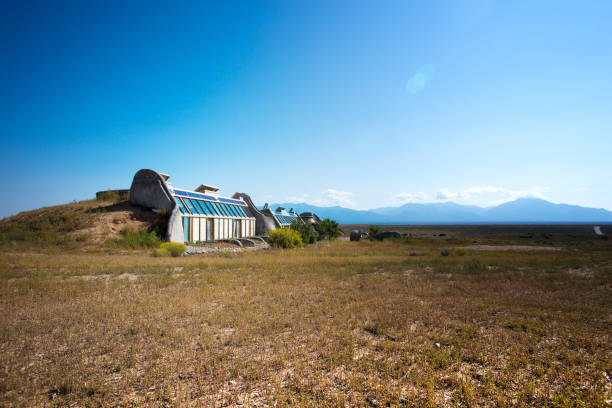
I had a great question about the permaculture principle of Use and Value Renewables.
Jeffery wonders how this principle applies to things like plastics and other materials that are not biodegradable. He asks if it’s possible to use these materials in a permaculture system in a way that is still sustainable?
Yes!
It absolutely is!
Even though it is easy to say “Don’t buy anything in plastic bottles,” it’s not so easy to do. Simply not buying stuff in plastic isn’t the solution. As long as everybody else is buying stuff in plastic, our not buying it won’t make much of a dent. The problem is systemic. And we, as a system, need to stop producing so much garbage.
There’s a lot of momentum in the wrong direction. It won’t stop over night. The state where I live, Colorado, recently passed a law declaring stores can no longer give plastic grocery bags away for free. They cost 10 cents each now. And people’s shopping carts are suddenly all full of re-usable grocery bags. Which is great. It’s nowhere near enough, but it’s great.
Way too many of the groceries, themselves, come in plastic bags or containers. Rice. Hummus. Bottled water–UGH! — an evil unto itself. Aisles and aisles of detergents. Hideous microwave dinners that nobody should be eating anyway. Even produce is sometimes shrink-wrapped in plastic. The bulk section even uses plastic bags. It’s, literally, everywhere. And it’s horrifying.
A cool thing we can do in the mean time, is to use this garbage to make things. I found this website by a woman who makes eco-bricks out of plastic bottles and then uses them to construct buildings. Go check it out.
In a nutshell, what you do is stuff plastic bottles full of other plastic garbage. Stuff it in super tight. Use a stick to smash it in. Then they can be used like bricks, to build buildings. It’s pretty ugly, so you’d want to stucco over them with cement or cob, (reinforced, first, with tightly wrapped chicken wire). Not only does it get rid of a bunch of garbage, it is a free building material that is super strong. 20 times stronger than clay bricks, in fact.
This woman Tanya is going a great thing. But she’s doing it in Vietnam. Could those of us in the first world get away with this? Probably not, in most cases. It all depends on your local building codes. If you find this as inspiring as it truly is, and want to do it, but don’t have your land yet, I would suggest building this into your search parameters. First find a county that would let you do it, then look for property there.
But if you already have your property, you could use this method for retaining walls, raised beds, pathways, little storage sheds, dog houses, large, elaborate benches…anything that flies under the radar of your local building codes. Maybe you could do a whole sculpture garden and get the local paper to do a story on it.
Earth Ship Biotecture is a fabulous way to turn garbage into renewables. Tires, cans and glass bottles are the main things that are used to create beautiful self-sufficient houses. I mean, they are GORGEOUS!!!

But again, you can’t just start building one. There are building codes in the way. Mike Reynolds, the innovator of Earth Ship Biotecture had to go through a four year fight to get Taos county, NM, to finally allow it. He actually had to write a new law. Most of us are not in a position to do this…or at least we don’t believe ourselves to be. But this kind of fight, down at our local land use offices and state legislators, has to be part of the process if we want to change the way the current unworkable things are done.

Mike Reynolds does not equate his work with Permaculture. He’s an architect. He says he’s not a goody two shoes save the planet type. He says it’s just logical. But saving the planet is extremely logical. Using every drop of collected rainwater four times is extremely logical. Using tires to create a landmass that keeps internal temperatures around 70 degrees Fahrenheit, year round, regardless of how hot or cold it is outside is extremely logical. Using up cans to build walls and colored glass bottles to build more walls, with beautiful light patterns shining through, is extremely logical.
Earth Ship Biotecture is completely compatible with Permaculture Principles.
That’s the thing about Permaculture. The Principles are written in a very simple way. But their meanings are vast and extend well beyond just permaculture, as a system. They mimic the natural process of life, and like life…encompass everything.

Hope you found this interesting and inspiring. As always, I love to hear from you in the comments.








Hi Anna-Vita,
I enjoyed reading your article about using non-biodegradable materials in a permaculture system. I think it’s important to find ways to reduce our reliance on plastics and other harmful materials, and I’m glad you’re highlighting some of the innovative ways that people are doing this.
I especially like the idea of using eco-bricks to build structures. It’s a great way to reuse plastic waste and create something that is both strong and sustainable. I’m also intrigued by Earthship Biotecture. It’s amazing to see how these homes are able to use recycled materials to create comfortable and self-sufficient living spaces.
I think these are just a few examples of the many ways that we can use non-biodegradable materials in a sustainable way. As you mentioned, it’s important to be creative and think outside the box. By working together, we can find ways to reduce our environmental impact and create a more sustainable future.
Thanks for sharing your article!
Hi Jeffery!
Thanks for the great question that inspired me to write it!
xxoo,
Anna
Wow, this blog post is truly thought-provoking and inspiring! The author, Anna-Vita, does an excellent job of highlighting the challenges we face with plastic waste and the importance of finding sustainable solutions within the permaculture framework. I appreciate Jeffery’s question about how to incorporate non-biodegradable materials like plastics into a permaculture system.
Anna-Vita’s response is spot on. She acknowledges that simply not buying plastic items is not enough to solve the problem, as the issue is systemic. It’s refreshing to see her emphasize the need for a collective effort to reduce the production of garbage. The recent change in Colorado’s law regarding plastic grocery bags is a step in the right direction, but more needs to be done.
The idea of repurposing plastic waste into building materials is fascinating. The concept of eco-bricks, as demonstrated by the woman mentioned in the blog post, is not only a creative solution to waste management but also a sustainable approach to construction. I wonder if such innovative practices could be implemented on a larger scale in the first world, considering local building codes and regulations. It would be interesting to learn about other countries or communities that have successfully adopted similar practices.
The mention of Earth Ship Biotecture and the construction of self-sufficient houses using discarded materials like tires, cans, and glass bottles is truly captivating. These structures not only address the issue of waste but also serve as aesthetically pleasing, environmentally friendly homes. However, the mention of the bureaucratic hurdles faced by Mike Reynolds in getting approval for Earth Ship Biotecture in Taos County, New Mexico, raises an important point. While these alternative approaches are logical and compatible with permaculture principles, there is a need for greater acceptance and support from local authorities and policymakers.
Overall, this blog post offers valuable insights into the challenges and possibilities of incorporating non-biodegradable materials into permaculture systems. It sparks a discussion on the systemic changes needed to address the issue of waste and highlights the innovative solutions that individuals like Tanya and Mike Reynolds are implementing. I am inspired by the potential for creative problem-solving and look forward to further exploring these concepts.
Warm Regards
M.T. Wolf
Hey Mike-
Thanks.
Yeah. Garbage is a major issue. At the rate we’re going, it’s probably going to be a long time before there is no more garbage being made. In the mean time, using it to make stuff makes sense…assuming we can even get cooperation from the so-called authorities.
Anna
The use and value of renewables principles encourage using resources that can be replenished and promote a circular economy. Applying this principle to non_blodegradable materials challenges us to find ways to keep these materials in use and out of landfills. In conclusion the discussion opens up exciting opportunities to rethink how we use non-biodegradable materials.
Glad you think so, Liam
Yes, problems are opportunities to use our creative thinking 🙂